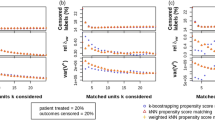Abstract
In the analysis of observational studies, propensity score subclassification has been shown to be a powerful method for adjusting unbalanced covariates for the purpose of causal inferences. One practical difficulty in carrying out such an analysis is to obtain a correct variance estimate for inference, while reducing bias in the estimate of the treatment effect due to an imbalance in the measured covariates. In this paper, we propose a bootstrap procedure for the inferences concerning the average treatment effect; our bootstrap method is based on an extension of Efron's bias-corrected accelerated (BCa) bootstrap confidence interval to a two-sample problem. Unlike the currently available inference procedures based on propensity score subclassifications, the validity of the proposed method does not rely on a particular form of variance estimation. A brief simulation study is included to evaluate the operating characteristics of the proposed procedure. We conclude the paper by illustrating the new procedure through a clinical application comparing the renal effects of two non-steroidal anti-inammatory drugs (NSAIDs).
Similar content being viewed by others
References
Bunning, R. and Barth, W., “Sulindac: A potentially renal-sparing nonsteroidal anti-immflammatory drug,” Journal of the American Medical Association 248, 2864-2867, 1982.
Ciabatonni, G., Cinotti, G., and Pierucci, A., “Effects of sulindac and ibuprofen in patientcs with chronic glomerrular disease: Evidence for the dependence of renal function on prostacylin,” New England Journal of Medicine 310, 279-283, 1984.
D'Agostino, R.B., “Propensity score methods for bias reduction in the comparison of a treatment to a nonrandomized control group,” Statistics in Medicine 17, 2265-2281, 1998.
Du, J., “Valid Inferences after propensity score subclassification using maximum number of subclasses as building blocks,” Ph.D. thesis, Harvard University, Cambridge, Massachusetts, 1998.
Efron, B., “Bootstrap confidence interval for a class of parametric problems,” Biometirka 72, 45-58, 1985.
Efron, B., “Better bootstrap confidence intervals,” Journal of the American Statistical Association 82, 171-200, 1987.
Efron, B. and Tibshirani, R.J., An introduction to the bootstrap, Chapman and Hall, New York, 1993.
Efron, B. and Tibshrani, R., “Bootstrap methods for standard errors, confidence intervals, and other measures of statistical accuracy,” Statistical Science 1, 54-75, 1986.
Greenland, S., Robins, J.M., and Pearl, J., “Confounding and collapsibility in causal inference,” Statistical Science 14, 29-46, 1999.
Hall, P., The bootstrap and edgeworth expension, Springer-Verlag, New York, 1992.
Hall, P. and Martin, M., “On the bootstrap and two-sample problems,” Australian Journal of Statistics 30A, 179-192, 1988.
McDonals, C., Overhage, J., and Tierney, W., “The Regenstrief medical record system: A quarter century experience,” Int. J. Med. Inf. 54, 225-253, 1999.
Murray, M. and Brater, D.C., “Renal toxicity of nonseroidal anti-imflammatory drugs,” Annual Reviews of Pharmacological Toxicology 32, 435-465, 1993.
Murray, M.D., Greene, P.K., and Kuzmik, D., “Effects of nonsteroidal anti-inflammatory drugs on glomerular filtration rate in elderly patients without and with renal insufficiency,” American Journal of Medical Sciences 310, 188-197, 1995.
Perkins, S.M., Tu, W., Underhill, M.G., Zhou, X.-H., and Murray, M.D., “The use of propensity scores in pharmacoepidemiologic research,” Pharmacoepidemiology and Drug Safety 9, 93-101, 2000.
Rosenbaum, P.R. and Rubin, D.B., “Reducing bias in observational studies using subclassification on the propensity score,” Journal of the American Statistical Association 79, 516-524, 1984.
Rosenbaum, P. and Rubin, D.B., “Central role of the propensity score in observational studies for causal effects,” Biometrika 70, 41-55, 1983.
Rubin, D.B., “Using multivariate matched sampling and regression adjustment to control bias in observational studies,” Journal of the American Statistical Association 74, 318-328, 1979.
Rubin, D.B., “Estimating causal effects from large data sets using propensity scores,” Annals of Internal Medicine 127(8), 757-763, 1997.
Sauerbrei, W., “The use of resampling methods to simplify regression modelss in medical statistics,” Journal of the Royal Statistical Society Series C-Applied Statistics 48(3), 313-329, 1999.
Sauerbrei, W. and Schumacher, M., “A bootstrap resampling procedure for model building-Application to the cox regression model,” Statistics in Medicine 11(16), 2093-2109, 1992.
Stone, R.A., Obrosky, D.S., and Singer, D.E., “Propensity score adjustment for pretreatment differences between hospitalized and ambulatory patients with community-acquired pneumonia,” Medical Care 33(4), 56-66, 1995.
Tu, W., Perkins, S.M., Zhou, X.-H., and Murray, M.D., “Testing treatment effect using propensity score strati-fication,” in 1999 Proceedings of section on statistics in epidemiology of the American statistical association, American Statistical Association, 105-107, 1999.
Author information
Authors and Affiliations
Corresponding author
Rights and permissions
About this article
Cite this article
Tu, W., Zhou, XH. A Bootstrap Confidence Interval Procedure for the Treatment Effect Using Propensity Score Subclassification. Health Services & Outcomes Research Methodology 3, 135–147 (2002). https://doi.org/10.1023/A:1024212107921
Issue Date:
DOI: https://doi.org/10.1023/A:1024212107921




